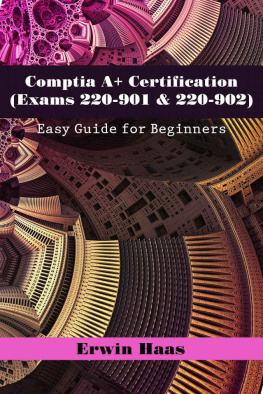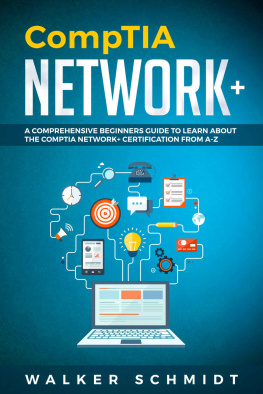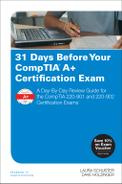Erwin Haas - Comptia A+ Certification (Exams 220-901 & 220-902): Easy Guide for Beginners
Here you can read online Erwin Haas - Comptia A+ Certification (Exams 220-901 & 220-902): Easy Guide for Beginners full text of the book (entire story) in english for free. Download pdf and epub, get meaning, cover and reviews about this ebook. year: 2017, genre: Romance novel. Description of the work, (preface) as well as reviews are available. Best literature library LitArk.com created for fans of good reading and offers a wide selection of genres:
Romance novel
Science fiction
Adventure
Detective
Science
History
Home and family
Prose
Art
Politics
Computer
Non-fiction
Religion
Business
Children
Humor
Choose a favorite category and find really read worthwhile books. Enjoy immersion in the world of imagination, feel the emotions of the characters or learn something new for yourself, make an fascinating discovery.
- Book:Comptia A+ Certification (Exams 220-901 & 220-902): Easy Guide for Beginners
- Author:
- Genre:
- Year:2017
- Rating:5 / 5
- Favourites:Add to favourites
- Your mark:
- 100
- 1
- 2
- 3
- 4
- 5
Comptia A+ Certification (Exams 220-901 & 220-902): Easy Guide for Beginners: summary, description and annotation
We offer to read an annotation, description, summary or preface (depends on what the author of the book "Comptia A+ Certification (Exams 220-901 & 220-902): Easy Guide for Beginners" wrote himself). If you haven't found the necessary information about the book — write in the comments, we will try to find it.
Erwin Haas: author's other books
Who wrote Comptia A+ Certification (Exams 220-901 & 220-902): Easy Guide for Beginners? Find out the surname, the name of the author of the book and a list of all author's works by series.
Comptia A+ Certification (Exams 220-901 & 220-902): Easy Guide for Beginners — read online for free the complete book (whole text) full work
Below is the text of the book, divided by pages. System saving the place of the last page read, allows you to conveniently read the book "Comptia A+ Certification (Exams 220-901 & 220-902): Easy Guide for Beginners" online for free, without having to search again every time where you left off. Put a bookmark, and you can go to the page where you finished reading at any time.
Font size:
Interval:
Bookmark:
Comptia A+ Certification (Exams 220-901 & 220-902)
Easy Guide for Beginners
By Erwin Haas
Copyright2017 by Erwin Haas
All Rights Reserved
Copyright 2017 by Erwin Haas
All rights reserved. No part of this publication may be reproduced, distributed, or transmitted in any form or by any means, including photocopying, recording, or other electronic or mechanical methods, without the prior written permission of the author, except in the case of brief quotations embodied in critical reviews and certain other noncommercial uses permitted by copyright law.
Table of Contents
Disclaimer
While all attempts have been made to verify the information provided in this book, the author does assume any responsibility for errors, omissions, or contrary interpretations of the subject matter contained within. The information provided in this book is for educational and entertainment purposes only. The reader is responsible for his or her own actions and the author does not accept any responsibilities for any liabilities or damages, real or perceived, resulting from the use of this information.
The trademarks that are used are without any consent, and the publication of the trademark is without permission or backing by the trademark owner. All trademarks and brands within this book are for clarifying purposes only and are the owned by the owners themselves, not affiliated with this document. **
Introduction
The Comptia A+ Certification (Exams 220-901 & 220-902) exam tackles a number of topics. For you to pass this certification exam, you have to read these topics. This book is an exploration of the topics which are tested in this exam. Enjoy reading!
Chapter 1- Hardware
The Motherboard
The PC motherboard is made up of a mixture of hardware. The design of the motherboard may seem to be very standardized, but the fact is that its original design has evolved too much since the inception. In this exam, these are broken down based on their design, the form factor, as well as based on the standard governing them. The following are form factors which are important for the exam:
ATX
This forms the standard motherboard size. This forms the platform for the workstations and the gaming PCs. The form factor specification for this calls for a size which measures 12.0 by 9.6. Note that the processor which is to be used is based on what fits in the socket for the motherboard which you have chosen.
Micro-ATX
For the overall size of the PCs to be reduced, the introduction of smaller form factors was done. The Micro-ATX was one of them, and it shaves a few inches off the length (9.6 by 9.6). This one shares a similar power supply connections together with an Input/output back panel. It is capable of replacing the full size ATX motherboard. However, it may have an on-board audio. This type has at least a single expansion slot which a riser card can use.
Mini- ITX (ITX)
This is the best for those who are more interested in silence more than performance. However, note that we are not saying that the performance will generate noise, but what it does is that it generates heat which needs cooling, and this comes with noise. Also, due to its size, it will accommodate only fewer components.
The Expansion Slots
Let us discuss some of the expansion slots which are covered in the A+ 220-901 exam:
PCI
The 32 bit PCI (the Peripheral Component Interconnect) bus forms the oldest model of expansion slot which is covered in this exam. It is available in both 32 and 64 bit versions, and it is used for connecting the legacy hardware to a PC.
This PCI was then replaced by the PCI Express (PCI-e) that is the only one which you will practically use and see today.
PCI-X
PCI-X (in which X is for eXpress) has both the 32 and 64 bit slots which are designed so as to be backward compatible with the 32 bit PCI cards. The cards have been designed so that they can be used at 3.3 V. The voltage portion slot of this slot goes beyond what a 32 bit 3.3 V card is capable of reaching.
PCI-E
This is another variation of the PCI (where E is for Express). Note that the PCIe and the PCI-X are currently not compatible with one another. When you are using the PCI-Express, you will have 16 lanes of communication available. The number of slots which it may utilize will be determined by the physixal size of the card. A good example of this is the x 16 slot which is capable of accommodating an x 1 card. When slots are used together, one will enjoy the increased bandwidth.
Mini-PCI
True computer portability was introduced in laptops after the introduction of a mini-PCI card. This can either be a modem or a wireless interface card. Some improvements have been implemented, but the real untethered portability was introduced by this standard.
RAM and CPU Sockets
The RAM slot is an integral component of the motherboard. In the case of the A+ exam, you should know the different types of RAM and its characteristics, and the best ones for high-performance servers and workstations.
DDR RAM
DDR (Double Data Rate) forms the standard RAM which is used in the majority of the PCs today. The DDR RAM comes in a number of versions which include the following:
- DDR, which was first released at around 2000.
- DDR2, which uses less power and doubled the DDR performance.
- DDR3, which uses even less power and doubled the performance of the DDR2.
The DDR4 RAM is also available, and it is beginning to reach the consumer machines. It is expected that the next generation of the PCs which run the upcoming Skylake processors for Intel should offer a better support for the DDR4 RAM.
The type of RAM which is to be installed is determined by the type of the motherboard which is being used. Each DDR version has own unique and notched module shape, meaning the wrong version of the DDR RAM cannot be installed on the motherboard which does not support it.
DIMMs and SODIMMs
The DDR RAM has two primary physical sizes, that is, the DIMMs and the SODIMMs. DIMM is for Dual In-line Memory Module, while SODIMM is for Small Outline Dual In-line Memory Module. The DIMMS are widely used in the desktop computers as well as in servers, while the SODIMMS are commonly used in the laptop computers.
RAM Characteristics
The following are the characteristics of RAM which you should know for the purpose of the exam:
- Parity vs. Non-parity
The older versions of the RAM were available in either parity or non-parity types. A parity RAM is capable of detecting the memory-based data errors (without correcting them), while the non-parity RAM doesnt have this kind of function.
The parity RAM was largely made obsolete by the ECC RAM.
- ECC RAM
Error-Correcting Code (ECC) RAM is capable of doing both detection and correction of memory-based data errors. ECC RAM is commonly used in critical servers where data corruption cannot be tolerated. The ECC RAM is a bit expensive, and it needs ECC-supporting processors and motherboards that are more expensive too.
- Buffered vs. Unbuffered
Buffered RAM puts less power load on the memory controller of the system. This becomes good when one has a lot of RAM already installed in the machine, as is the case with the high-performance servers. The regular workstations always have an unbuffered RAM installed.
- Single-sided vs. Double-sided
If all the RAM chips are located on one side of your RAM module, then this is referred to as a single-sided RAM. If it has chips on both sides of the module, then it is referred to as a double-sided RAM. The single-sided RAM is a bit newer, and the older motherboards may encounter trouble when trying to recognize it.
Next pageFont size:
Interval:
Bookmark:
Similar books «Comptia A+ Certification (Exams 220-901 & 220-902): Easy Guide for Beginners»
Look at similar books to Comptia A+ Certification (Exams 220-901 & 220-902): Easy Guide for Beginners. We have selected literature similar in name and meaning in the hope of providing readers with more options to find new, interesting, not yet read works.
Discussion, reviews of the book Comptia A+ Certification (Exams 220-901 & 220-902): Easy Guide for Beginners and just readers' own opinions. Leave your comments, write what you think about the work, its meaning or the main characters. Specify what exactly you liked and what you didn't like, and why you think so.





